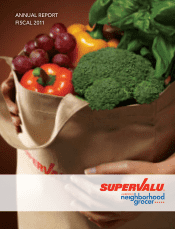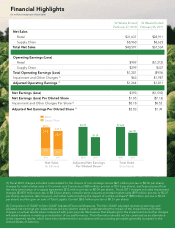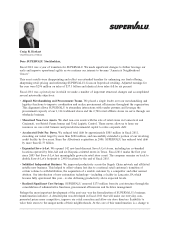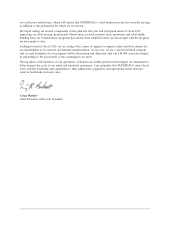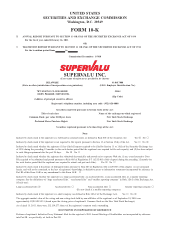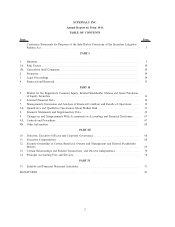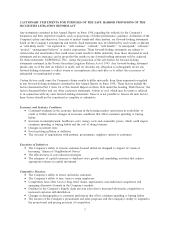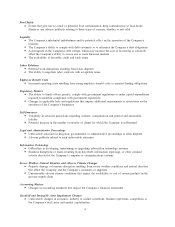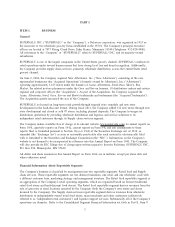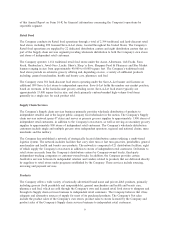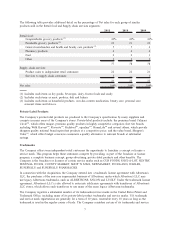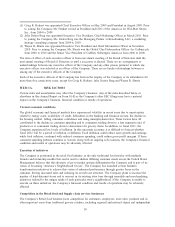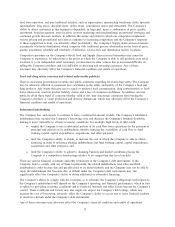Albertsons 2011 Annual Report Download - page 7
Download and view the complete annual report
Please find page 7 of the 2011 Albertsons annual report below. You can navigate through the pages in the report by either clicking on the pages listed below, or by using the keyword search tool below to find specific information within the annual report.CAUTIONARY STATEMENTS FOR PURPOSES OF THE SAFE HARBOR PROVISIONS OF THE
SECURITIES LITIGATION REFORM ACT
Any statements contained in this Annual Report on Form 10-K regarding the outlook for the Company’s
businesses and their respective markets, such as projections of future performance, guidance, statements of the
Company’s plans and objectives, forecasts of market trends and other matters, are forward-looking statements
based on the Company’s assumptions and beliefs. Such statements may be identified by such words or phrases
as “will likely result,” “are expected to,” “will continue,” “outlook,” “will benefit,” “is anticipated,” “estimate,”
“project,” “management believes” or similar expressions. These forward-looking statements are subject to
certain risks and uncertainties that could cause actual results to differ materially from those discussed in such
statements and no assurance can be given that the results in any forward-looking statement will be achieved.
For these statements, SUPERVALU INC. claims the protection of the safe harbor for forward-looking
statements contained in the Private Securities Litigation Reform Act of 1995. Any forward-looking statement
speaks only as of the date on which it is made, and we disclaim any obligation to subsequently revise any
forward-looking statement to reflect events or circumstances after such date or to reflect the occurrence of
anticipated or unanticipated events.
Certain factors could cause the Company’s future results to differ materially from those expressed or implied
in any forward-looking statements contained in this Annual Report on Form 10-K. These factors include the
factors discussed in Part I, Item 1A of this Annual Report on Form 10-K under the heading “Risk Factors,” the
factors discussed below and any other cautionary statements, written or oral, which may be made or referred
to in connection with any such forward-looking statements. Since it is not possible to foresee all such factors,
these factors should not be considered as complete or exhaustive.
Economic and Industry Conditions
kContinued weakness in the economy, declines in the housing market, restrictions in availability of
credit or further adverse changes in economic conditions that affect consumer spending or buying
habits
kIncreases in unemployment, healthcare costs, energy costs and commodity prices, which could impact
consumer spending or buying habits and the cost of doing business
kChanges in interest rates
kFood and drug inflation or deflation
kThe outcome of negotiations with partners, governments, suppliers, unions or customers
Execution of Initiatives
kThe Company’s ability to execute customer-focused initiatives designed to support its vision of
becoming “America’s Neighborhood Grocer”
kThe effectiveness of cost reduction strategies
kThe adequacy of capital resources to fund new store growth and remodeling activities that achieve
appropriate returns on capital investment
Competitive Practices
kThe Company’s ability to attract and retain customers
kThe Company’s ability to hire, train or retain employees
kCompetition from other food or drug retail chains, supercenters, non-traditional competitors and
emerging alternative formats in the Company’s markets
kDeclines in the Company’s Supply chain services sales due to increased wholesaler competition or
increased customer self-distribution
kChanges in demographics or consumer preferences that affect consumer spending or buying habits
kThe success of the Company’s promotional and sales programs and the Company’s ability to respond to
the promotional and pricing practices of competitors
3

